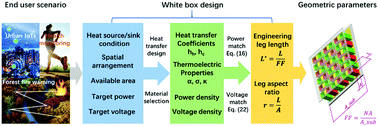System efficiency and power: the bridge between the device and system of a thermoelectric power generator†
Abstract
The thermoelectric efficiency formula (ηmax), derived by Ioffe, provides a direct connection between the material dimensionless figure of merit ZT and the maximum efficiency of transformation of heat into electricity in an ideal device with fixed terminal temperatures. However, for a thermoelectric power generator (TEG) system made for practical use, it could meet diverse temperature scopes and heat transfer conditions, making the terminal temperatures floating rather than fixed. Here, we define the optimized system efficiency and power output based on an analytical model that provides a connection between the device and the system by considering constant material properties and varying thermal circumstances. It is found that the dimensionless cold side thermal resistance fc has a larger inhibiting effect on the system performance than its hot side counterpart fh, suggesting more thermal management efforts should be placed on the cold side. Furthermore, a general system level design strategy is proposed to obtain the engineering leg length and the aspect ratio by considering the condition of external thermal resistance, output power and voltage match. As an example, a predicted 2–3 times enhancement was experimentally confirmed in a room temperature TEG device.



 Please wait while we load your content...
Please wait while we load your content...